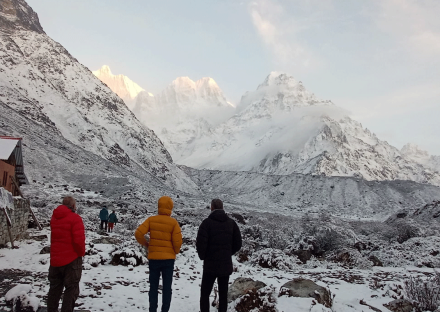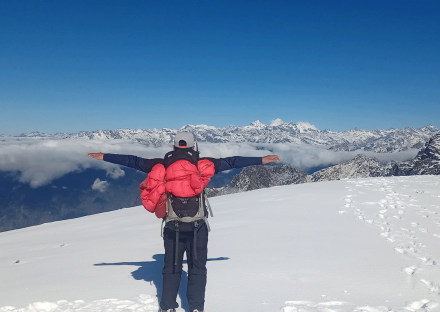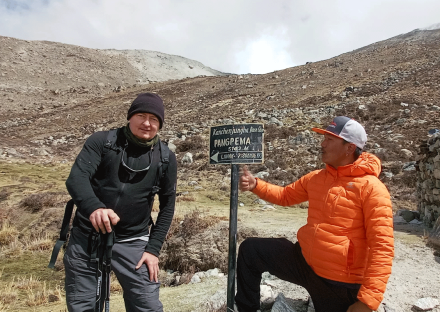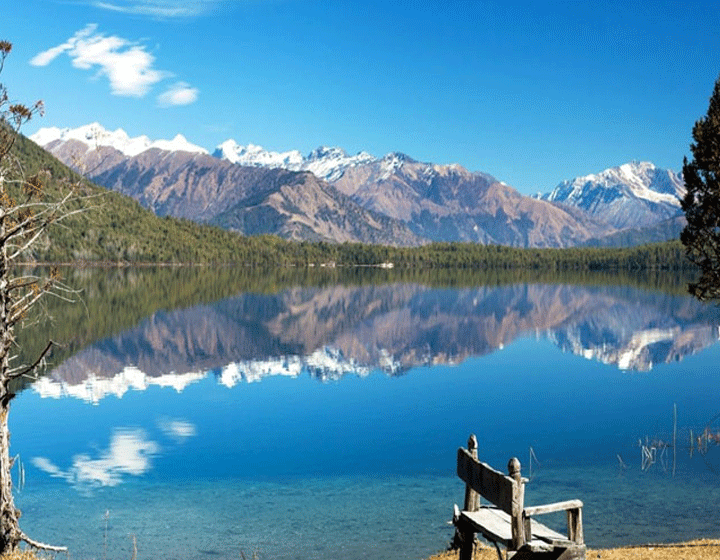
Trip overview
The Kanchenjunga Base Camp Trek is an adventure of raw wilderness, high peaks, and isolated villages, leading trekkers deep into the heart of eastern Nepal. Known for its challenging terrain, the 17 Days trek to Kanchenjunga Base Camp is not as widely traversed as the Annapurna or Everest regions, making it ideal for trekkers seeking solitude and pristine natural beauty. At 8,586 metres, Mount Kanchenjunga is the third-highest peak in the world and reaching its base camp is a monumental journey offering an unforgettable experience amid towering glaciers, diverse ecosystems, and unique cultural encounters.
The Kanchenjunga Base Camp Trek Nepal takes trekkers into a remote and culturally rich region of the Himalayas. Covering both the Kanchenjunga North and South Base Camp Trek, this allows visitors to experience panoramic views of Mount Kanchenjunga from various angles. This trail showcases Nepal’s biodiversity, including lush subtropical forests, rhododendron forests, and high-altitude terrains, where snow leopards and red pandas roam.
For those seeking an extended Himalayan journey. This trek provides a glimpse into traditional Tibetan Buddhist culture, particularly in settlements like Ghunsa and Pangpema. The Kanchenjunga Base Camp trek is long and strenuous. But offers a once-in-a-lifetime experience that rewards with surreal landscapes. And the satisfaction of completing one of the most rewarding and challenging treks in Nepal.
Highlights of Kanchenjunga Base Camp Trek
One of Nepal’s most breathtaking and off-the-beaten-path trekking experiences, the Kanchenjunga base camp trek is a distant and incredibly beautiful experience. Far from the crowds of Annapurna and Everest, the trek offers unadulterated Himalayan beauty, cultural richness, and pristine wilderness. The following are the key highlights of the trek:
- Close-Up Views of Mount Kanchenjunga (8,586m) : Enjoy stunning views of the world’s third-highest mountain from Pangpema (North Base Camp) and Oktang (South Base Camp). The panorama includes Jannu, Yalung Kang, and a host of other Himalayan giants.
- Off-the-beaten and Pristine Trails : Trek on remote trails that few foreigners have trodden. The Kanchenjunga base camp trek offers solitude, serenity, and the true spirit of adventure.
- Diverse Wildlife in Kanchenjunga Conservation Area : Discover secretive animals like red pandas, snow leopards, and Himalayan blue sheep in a protected habitat of rhododendron forests and alpine meadows.
- Traditional Himalayan Culture : Encounter Limbu, Rai, Sherpa, and Tibetan-influenced communities. Stay overnight in traditional homestays and interact with people who maintain ancient customs and language.
- Spiritual Landscapes and Sacred Sites : Visit monasteries, chortens, mani walls, and sacred caves along the route. The region has immense religious significance, especially to Tibetan Buddhist communities.
- Challenging Landscape and Scenic Diversity : Cross high passes, glacial streams, and low valleys. Every section of the Kanchenjunga base camp trek offers varying scenery—from subtropical slopes to glaciated landscapes.
- Unpredictable Weather and Dramatic Skies : Witness dramatic Himalayan weather patterns, cloud formations over snow-capped peaks, and starry nights at high camps—ideal for nature lovers and photographers.
- Sense of Offer : Reaching the base camp of Kanchenjunga is no small feat. The remoteness, altitude, and physical requirement render the experience immensely fulfilling for seasoned trekkers.
- North and South Base Camp Trek : In 17 Days Visiting both camps offers contrasting views and a fuller experience of the massif Mountains.
Trek to Kanchenjunga Base Camp Itinerary
The Trek to Kanchenjunga itinerary typically spans 17–25 days due to its distance, difficulty, and the need for acclimatization at high altitudes. The duration of the trek can be extended if you choose to hike, or shortened by opting for a jeep ride instead . We are flexible in tailoring the itinerary to match your interests. Here’s a general outline of the itinerary:
- Day 1–2: Arrival in Kathmandu and flight to Bhadrapur. Drive to Taplejung, the trek’s starting point.
- Day 3–6: Begin trekking from Taplejung, passing through villages like Mitlung, Chiruwa, and Sukethum, surrounded. By dense forests and terraced fields.
- Day 7–10: Ascend through Amjilosa, Gyabla, and reach Ghunsa, a Tibetan Buddhist village that’s perfect for acclimatisation.
- Day 11–14: Continue to Kanchenjunga North Base Camp Trek at Pang Pema, enjoying views of glaciers and the magnificent peak of Kanchenjunga.
- Day 15–19: Descend back to Ghunsa, then ascend toward the South, reaching high points that allow panoramic views of the surrounding peaks.
- Day 20–23: Begin the descent, passing villages en route back to Taplejung, then return to Kathmandu.
This itinerary ensures adequate acclimatisation, as the KBC height reaches 5,143 meters at Pang Pema, and adjusting gradually to high altitudes is essential. While some trekkers choose to explore only one of the base camps. Where as completing both the north and south camps provides a more comprehensive experience of the region.
Altitude and Physical Fitness
Kanchenjunga Base Camp Trek involves exposure to high-altitude Himalayan terrain, with elevations over 5,100 meters (16,732 ft) at Pang Pema, the north base camp. With a significant altitude gain, physical fitness is required for a pleasant and enjoyable trek.
Preparation includes building cardiovascular fitness through hiking, jogging, or biking. Strengthening the legs, core, and shoulders also prepares one for long walking days carrying a pack. Acclimatization is necessary because the danger of Acute Mountain Sickness (AMS) is greater at altitudes of over 3,000 meters. Climbing in the Kanchenjunga base camp trek is done gradually, allowing the body time to acclimatize.
Trekkers must be in good physical condition and ideally experienced in multi-day treks. Before embarking on the trek, it is strongly recommended to undergo a medical check-up. Adequate nutrition, correct pacing, and water intake during the trek also ensure successful acclimatization.
Flora and Wildlife of Kanchenjunga Base Camp Trek
The Kanchenjunga region comes under the Kanchenjunga Conservation Area, which is one of Nepal‘s most bio diverse places. The base camp trek to Kanchenjunga offers a chance to witness untouched wilderness, from forests to alpine grassland.
In the lower regions, trekking is along rhododendron, oak, pine, and bamboo forests. Spring (March–May) sees the trail decorate itself with blooming rhododendrons and orchids. When climbing upwards, vegetation shifts to juniper bushes, mosses, and alpine meadows near the glaciers.
Wildlife is rich and preserved. Himalayan blue sheep, red pandas, langurs, and even the elusive snow leopard are visible in the outlying areas. Bird enthusiasts can look out for Impeyan pheasants (Danphe), blood pheasants, and golden eagles. Preservation of these creatures takes top priority in this unspoiled, natural area, and the trek is a paradise for naturalists.
Kanchenjunga Base Camp Trek Distance
The trekking distance of Kanchenjunga base camp differs according to the route to be followed—North Base Camp, South Base Camp, or both as a circuit. On average, the entire Kanchenjunga circuit trek is around 220 to 240 kilometers (137 to 149 miles).
- North Base Camp by itself: Around 140–160 km (round trip)
- South Base Camp by itself: Around 120–140 km (round trip)
- Both Base Camps (Kanchenjunga Circuit Trek): 220–240 km total
This trek typically takes 15 to 22 days, depending on rest days, weather, acclimatization, and walking pace. Routes are remote from human habitation and tough, with hard climbings, river crossings, and high-altitude passes. The Kanchenjunga base camp trek is more remote than Everest or Annapurna, and thus trekkers have to be independent, well-prepared, and guided by a licensed guide or porter.
Kanchenjunga Base Camp Trek Difficulty
The trek difficulty level is high, making it suited for trekkers with experience in long-distance hiking and previous exposure to high-altitude terrain. This trek covers approximately the distance of 200 kilometers, with daily trekking durations often exceeding six hours and involving steep ascents and descents. The physical demands, unpredictable weather, and basic accommodations add to the trek’s difficulty.
Another factor influencing the trek’s difficulty is its remoteness. Unlike more popular trekking regions, the Kanchenjunga area has fewer lodges and amenities. Trekkers must be prepared for basic lodging and limited meal options. Additionally, the region’s trails are narrow and sometimes exposed to landslides. Especially during the monsoon season, requiring surefootedness and good navigation skills.
Permits and Cost for Kanchenjunga Base Camp Trek
Before beginning the 17 Days Kanchenjunga Base Camp Trek, trekkers must secure the necessary permits, such as the Conservation Area Entry Permit and the Restricted Area Permit. These are mandatory for accessing restricted areas and exploring the conservation region. Permit costs vary based on the trek duration and chosen services.
In addition to permits, trekkers should plan for expenses covering accommodations, meals, and the hiring of guides and porters. Essential trekking gear, including insulated clothing, durable hiking boots, trekking poles, and a reliable sleeping bag, will also ensure a more comfortable and successful journey.
Why to Choose Kanchenjunga Base Camp Trek?
The 17 days Kanchenjunga Base Camp Trek is ideal for trekkers looking to venture off the beaten path. It provides an unspoiled trekking experience with some of Nepal’s most breathtaking mountain scenery and cultural experiences that are rarely found in more commercialized trekking routes. The trek allows trekkers to witness a pristine, less-travelled part of the Himalayas that maintains its natural beauty and traditional way of life.
Why Choose NWT for Kanchenjunga Base Camp Trek?
Nepal Wilderness Trekking offers skilled guides with deep knowledge of the Kanchenjunga region, prioritizing safety and cultural insights. Itineraries are flexible, tailored to your pace and interests, and we emphasize eco-friendly practices to preserve the environment. With fair treatment of porters, transparent pricing, and highly-rated service. NWT ensures a smooth, rewarding journey to the Trek, combining expertise with genuine care for your trekking experience.
Kanchenjunga Base Camp Trek: An Unforgettable Journey
Trek to Kanchenjunga is a challenge with rewards that far surpass the physical efforts involved. From traversing deep valleys and remote villages. To ascending to the high-altitude camps with views of Kanchenjunga towering above, the trek embodies the essence of adventure. For seasoned trekkers, this trail offers a one-of-a-kind exploration of Nepal’s eastern Himalayas. Combining majestic mountain views, rich biodiversity, and a rare glimpse into the local cultures.
Choosing this trek provides a full perspective on this massive mountain, ensuring that trekkers can witness the grandeur of Kanchenjunga from multiple viewpoints. Though difficult, this trek’s blend of high-altitude challenges, scenic beauty, and cultural encounters makes it an unforgettable experience for any adventurous soul.
Note: The trek’s duration can be adjusted to suit your preference—extended for hiking or shortened with a jeep ride. We are happy to customize the itinerary to align with your interests.
Itinerary
Start early morning flight from Kathmandu to Bhadrapur, located in the southeastern Mechi Zone of Nepal. After scenic flight, start driving to Taplejung and offer stunning views of the hilly terrain and local villages along the way.
Drive: 8-9 hours
The 5–6 hour drive from Taplejung (1,820m) to Sukathum/Japantar (1,576m) offers stunning views of lush forests, terraced fields, and flowing rivers like the Tamor. The unpaved, winding road passes through traditional villages, showcasing local Limbu and Rai cultures.
The journey, though bumpy, immerses you in the natural beauty of eastern Nepal, ending at Sukathum/Japantar, key stops on the Kanchenjunga trekking route with basic accommodations.
This 5–6 hour trek climbs from Sukathum (1,576m) to Amjilosa (2,398m). The trail passes through lush forests, bamboo groves, and along the Ghunsa Khola, featuring waterfalls, suspension bridges, and serene views. Amjilosa, a small village with basic teahouses, offers a peaceful rest stop.
Trek through serene trails, passing waterfalls and streams. The lush forests gradually give way to open landscapes as you approach Gyabla.
Highlights: Expansive views, traditional Tibetan-style homes, and a growing sense of remoteness.
Walking Hours: 5-6 hours
Description: Today’s trek is a mix of gradual ascents and flat terrain, leading to Ghunsa, a vibrant Sherpa village. You’ll notice the culture shift as prayer flags and chortens dot the landscape.
Highlights: Yak pastures, monasteries, and warm Sherpa hospitality.
Walking Hours: 6-7 hours.
Spend the day acclimatising in Ghunsa. Short hikes to nearby viewpoints help your body adjust to the altitude. Explore the village and its Buddhist monastery.
Highlights: Stunning views of surrounding peaks, cultural immersion, and a peaceful atmosphere.
Walking Hours: 2-3 hours (optional).
The trail climbs alongside glacial rivers and across landslide-prone areas to reach Kambachen. The alpine terrain offers breathtaking mountain vistas.
Highlights: Panoramic views of Jannu Himal, glacial valleys, and rugged landscapes.
Walking Hours: 6-7 hours.
Trek through a rugged, barren landscape as you approach Lhonak, nestled beneath towering peaks.
Highlights: Jaw-dropping views of Kanchenjunga and surrounding glaciers.
Walking Hours: 5-6 hours.
Description: Hike to Pangpema, the Kanchenjunga North Base Camp, for spectacular close-up views of the massive Kanchenjunga massif. After soaking in the grandeur, return to Lhonak.
Highlights: Majestic Kanchenjunga, glacial moraines, and unworldly high-altitude terrain.
Walking Hours: 7-8 hours.
Retrace steps back to Ghunsa, enjoying the descending trail and revisiting familiar sights from a new perspective.
Highlights: Alpine scenery, river crossings, and comforting Sherpa hospitality.
Walking Hours: 6-7 hours.
Ascend through rugged paths to the Sele La Pass, surrounded by incredible mountain panoramas.
Highlights: Prayer flags marking the pass, sweeping Himalayan views.
Walking Hours: 6-7 hours.
Descend from the high pass to Cheram, passing through diverse landscapes ranging from barren hills to lush forests.
Highlights: Diverse terrain and serene surroundings.
Walking Hours: 5-6 hours.
Trek to Ramche and continue to the Kanchenjunga South Base Camp. Experience the grandeur of the southern face of the mountain before returning to Ramche.
Highlights: Towering glaciers, glistening icefalls, and up-close views of Kanchenjunga.
Walking Hours: 6-7 hours.
Descend through rhododendron forests and cross streams to reach Tortong.
Highlights: Lush greenery, vibrant rhododendron blooms, and peaceful trails.
Walking Hours: 6-7 hours.
The final trek from Tortong to Ranipul takes 5–6 hours, descending through lush forests, crossing rivers, and passing small settlements. The trail offers stunning views of the lower hills as you leave the high mountains behind. Ranipul marks the end of the trek, where transportation back to Taplejung can be arranged.
This 9–10 hour drive winds through the picturesque hills of eastern Nepal, passing terraced fields, dense forests, and small villages. As you approach Ilam, you'll be greeted by sprawling tea gardens and a refreshing mountain atmosphere. Kanyam, known for its scenic beauty, is an ideal place to relax and enjoy the serene landscape.
A 2.5–3 hour drive from Ilam (1,627m) to Bhadrapur (91m) takes you through lush tea gardens and scenic hills, descending to the lowlands. From Bhadrapur, a 35–40 minute flight brings you back to Kathmandu, offering breathtaking aerial views of the Himalayas.
Included
- Transfers between hotel and the domestic airport by car.
- Roundtrip flight tickets from Kathmandu to Bhadrapur and vice versa.
- Jeep transportation.
- Lodge accommodations during the trek.
- Three meals a day (breakfast, lunch, and dinner).
- Kanchenjunga special entrance permits.
- Experienced English-speaking trekking guide licensed by the government and familiar with the area
- Microspikes for trekking during the winter season (December to February).
- Kit bag for storing belongings during the trek
- Sleeping bag suitable for temperatures as low as -25°C.
- One porter for every two to three participants. (Note: Solo clients requiring a porter will incur an additional cost.)
- Guide's porter, including food, lodge, transportation (air/bus), salary, insurance, and equipment.
- Necessary paperwork, including all government and local taxes.
- A certificate of appreciation from Nepal Wilderness Trekking upon completing the trek.
Not Included
- Airfare for international flights.
- Nepal entry visa fees upon arrival at Tribhuvan International Airport. (15 days: $25–30; 30 days: $ 40–50, etc.)Hotel accommodation in Kathmandu.
- Personal trekking equipment suitable for high-altitude and cold temperatures.
- Travel insurance covering emergency high-altitude rescue and evacuation.
- Beverages, including soft drinks, caffeinated drinks, beer, and others.
- Drinking water, desserts, and laundry services.
- Tips for guides and porters.
- Costs and expenses not explicitly listed under "Cost Included."
- Additional costs or delays beyond management's control, such as landslides, extreme weather, itinerary changes due to safety concerns, illness, changes in government policies, or strikes.
Join Us Upcoming Trips
Book this trip with us. Here are the upcoming dates. Feel free to share this trip with your friends and family. For custom trips or general inquiries contact us.
| Departure Date | Trip Duration | Price | Status | |
|---|---|---|---|---|
| 04 August, 2025 | 17 Days | $1570 | Available | |
| 10 August, 2025 | 17 Days | $1570 | Available | |
| 18 August, 2025 | 17 Days | $1570 | Available | |
| 26 August, 2025 | 17 Days | $1570 | Available | |
| 05 September, 2025 | 17 Days | $1570 | Available | |
| 10 September, 2025 | 17 Days | $1570 | Available | |
| 15 September, 2025 | 17 Days | $1570 | Available | |
| 20 September, 2025 | 17 Days | $1570 | Available | |
| 30 September, 2025 | 17 Days | $1570 | Available | |
| 01 October, 2025 | 17 Days | $1570 | Available | |
| 06 October, 2025 | 17 Days | $1570 | Available | |
| 10 October, 2025 | 17 Days | $1570 | Available | |
| 15 October, 2025 | 17 Days | $1570 | Available | |
| 21 October, 2025 | 17 Days | $1570 | Available | |
| 26 October, 2025 | 17 Days | $1570 | Available | |
| 02 November, 2025 | 17 Days | $1570 | Available | |
| 06 November, 2025 | 17 Days | $1570 | Available | |
| 11 November, 2025 | 17 Days | $1570 | Available | |
| 17 November, 2025 | 17 Days | $1570 | Available | |
| 25 November, 2025 | 17 Days | $1570 | Available | |
| 30 November, 2025 | 17 Days | $1570 | Available | |
| 08 December, 2025 | 17 Days | $1570 | Available | |
| 16 December, 2025 | 17 Days | $1570 | Available |
Useful Info
Best Time for Trek to Kanchenjunga Base Camp
The best time to undertake the 17 days Trek to Kanchenjunga is during the pre-monsoon (March to May) and post-monsoon (September to November) seasons. During these months, the weather is stable, offering clear skies, favourable temperatures, and vibrant landscapes. Spring brings blooming rhododendrons, enhancing the beauty of the forests, while autumn provides crystal-clear mountain views. Winter trekking is possible but challenging due to the snow and cold at higher elevations.
Travel Insurance
Travel insurance is non-negotiable for the Kanchenjunga Base Camp Trek due to its remote location, unpredictable mountain weather, and high elevation. Standard policies often do not cover treks above 3,000 meters, so it is crucial to choose a provider that includes coverage for high-altitude trekking up to 5,200 meters. Your insurance should cover emergency helicopter evacuations, which are the fastest means of rescue in case of altitude sickness or serious injuries. Look for policies that also include medical treatments abroad, trip cancellations, delayed departures, lost baggage, and personal liability. Trekkers should keep both a digital and a printed copy of the policy documents, and share the details with us before the trek.
Accommodation
While the Kanchenjunga region is less commercialized than other trekking destinations in Nepal, it still offers basic teahouses and community-run homestays in key villages like Taplejung, Ghunsa, and Yamphudin. These accommodations are modest but welcoming, typically providing a single bed with a foam mattress, woolen blankets, and shared toilet facilities. Heating is rare, except around the kitchen area, so a warm sleeping bag is essential. Some teahouses offer home-cooked meals, creating a unique chance to experience the local Limbu, Rai, and Sherpa cultures.
Internet and Connectivity
Connectivity in the Kanchenjunga region is very limited and unreliable. While mobile networks such as NTC (Nepal Telecom) may function sporadically in lower-altitude villages, no stable signal is available at higher elevations or isolated campsites. There are no Wi-Fi facilities in most areas, and power outages are common. Charging electronics may require an additional fee, and outlets are scarce, so trekkers are advised to carry power banks or solar chargers. For those needing consistent communication or navigation, a satellite phone or GPS device is a valuable tool. Disconnecting from the digital world, however, offers a rare opportunity to be fully present in the serenity of the Himalayas.
Packing Essentials
Thorough packing is vital for a successful Kanchenjunga Base Camp Trek due to the diverse terrain, fluctuating temperatures, and limited resources en route. Begin with layered clothing: moisture-wicking base layers, fleece or down insulation, and waterproof outerwear. Include thermal underwear, a windproof jacket, trekking trousers, and warm gloves. A quality -15°C rated sleeping bag is essential, as teahouse rooms and campsites can be extremely cold at night. Footwear should include broken-in trekking boots with good ankle support and warm socks. Other essentials include UV-protection sunglasses, sunscreen, a wide-brimmed hat, headlamp with extra batteries, trekking poles, and a sturdy daypack. Don’t forget a water purification system, whether tablets, filters, or UV devices, as tap water is not safe to drink. A basic first-aid kit, including medications for altitude sickness, diarrhea, and blisters, should also be included in every trekker’s gear. For in details visit here for packing list for trekking in Nepal.
Meals on the Trek
The food available on the Kanchenjunga Base Camp Trek is simple but nourishing, prepared using local ingredients and tailored to support the high-energy demands of trekking. The staple dish is dal bhat, a combination of steamed rice, lentil soup, vegetables, and sometimes pickles or curried meat. It’s rich in carbohydrates and refilled generously. Other common options include thukpa (a hearty noodle soup), Tibetan bread, boiled potatoes, momos (dumplings), and tsampa (roasted barley flour). Breakfast often consists of porridge, pancakes, or eggs. While the choices are limited, the meals are filling and warm, helping trekkers replenish after long hiking hours. Trekkers are advised to bring energy bars, nuts, dried fruits, and instant drinks like electrolyte powders or tea bags for added variety and nutrition. Hydration is crucial, and trekkers should drink 3–4 liters of water per day using purified sources to avoid gastrointestinal issues.
Kanchenjunga Base Camp Trek Booking Procedure
Booking your Kanchenjunga Base Camp trek with Nepal Wilderness Trekking is smooth, transparent, and traveler-friendly. Here's how it works:
1. Choose Your Trek
Browse our trekking packages and select the Kanchenjunga trek—or consult our team if you're unsure which route best fits your interests and fitness level.
2. Contact Us
Reach out to us via:
- Email: info@everestbasecamphike.com OR ebchike99@gmail.com
- WhatsApp : +977 9851205116
- Contact Form: Available on our website
Let us know your preferred travel dates, group size, and any special requests.
3. Customize Your Trip
We offer flexible itineraries. Whether you want to adjust the trek duration, add rest days, or include cultural add-ons, we’ll tailor the trip to your preferences.
4. Confirm Your Booking
Once your custom itinerary and cost are finalized, confirm your trek with a 25% deposit. This allows us to secure permits, accommodation, and logistics in advance.
5. Payment Options
We accept:
- Bank Transfers
- Western Union
- Online Gateway (on request)
The remaining balance can be paid either in Kathmandu (cash or card) or in advance.
6. Booking Confirmation
After receiving your deposit, we’ll send you a confirmation email with:
- Finalized itinerary
- Essential gear checklist
- Travel preparation tips
- Arrival instructions
7. Start Your Adventure
Arrive in Kathmandu—we’ll meet you at the airport and handle everything from permits to guide services. Just enjoy your trek to the majestic Kanchenjunga Base Camp.
FAQs
-
Is Kanchenjunga base camp trek difficult?
The Kanchenjunga Base Camp trek is considered difficult due to its remote terrain, long duration, high altitude, and limited facilities along the route. Proper preparation and fitness are essential.
-
How long is the trek to Kanchenjunga base camp?
The Kanchenjunga Base Camp trek typically takes 20–24 days, depending on the chosen itinerary. However, with the option of a jeep ride, the trek can now be completed in just 17 days, offering a more streamlined itinerary.














